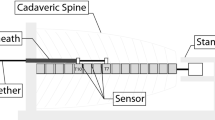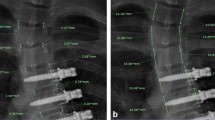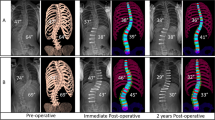Abstract
Study design
Experimental in vivo study of the pressure exerted on the spine of a pig by a new cyclic anterior vertebral body tethering (AVBT) prototype.
Objectives
To evaluate the relationship between the tether tension and the pressures transmitted onto the vertebral end plates by a cyclic AVBT prototype.
Summary of background data
AVBT is a recent surgical technique for the treatment of pediatric scoliosis that compresses the convex side of the spine with a sustained tension, to modulate the growth to progressively correct the deformity over time. Previous studies demonstrated that cyclic compression has similar growth modulation capacity but with less detrimental effects on the integrity of the discs and growth plates.
Methods
A 3-month-old healthy Duroc pig was anesthetized and a lateral thoracotomy was performed. The T7–T10 segment was instrumented and compressed during 50 s with the load oscillating (0.2 Hz) from + 30 to − 30% of the following mean tensions: 29, 35, 40, 44, and 49 N. The pressure exerted on T9 superior vertebral end plate was monitored during the cyclic loading. Three repetitions of each test were performed.
Results
The resulting mean pressure exerted on the vertebral end plate was linearly correlated with the mean tether tension (r2 = 0.86). Each cycle translated in a hysteresis profile of the measured pressure and tension, with amplitudes varying between ± 11.5 and ± 29.9%.
Conclusions
This experimental study documented the relationship between the tether tension and the pressure. This study confirmed the feasibility of cyclic AVBT principle to transfer varying pressures on the vertebral end plates, which is intended to control vertebral growth, while keeping the spine flexibility and preserving the health of soft tissues such as the intervertebral discs and the growth plate but remained to be further verified.
Level of evidence
Level IV.






Similar content being viewed by others
References
Pahys JM, et al (2015) The first 100 consecutive anterior vertebral body tethering procedures for immature adolescent idiopathic scoliosis at a single institution: outcomes and complications in the early postoperative period. Paper presented at: IMAST 2015: International Meeting on Advanced Spine Techniques; July 8-–11, 2015, Kuala Lumpur; 200–1
Newton PO, Saito W, Burt Y, et al (2016) Successes and failures following spinal growth tethering for scoliosis—a retrospective look 2–4 years later. Paper presented at: 51st Annual Meeting and Course of the Scoliosis Research Society, September 21–24, 2016; Prague, Czech Republic
Cobetto N, Parent S, Aubin CE (2018) 3D correction over 2 years with anterior vertebral body growth modulation: a finite element analysis of screw positioning, cable tensioning and postoperative functional activities. Clin Biomech 51:26–33
Cobetto N, Aubin CE, Parent S (2018) Surgical planning and follow-up of anterior vertebral body growth modulation in pediatric idiopathic scoliosis using a patient-specific finite element model integrating growth modulation. Spine Deform 6:344–350
Driscoll M, Aubin CE, Moreau A, Parent S (2011) Biomechanical comparison of fusionless growth modulation corrective techniques in pediatric scoliosis. Med Biol Eng Comput 49:1437–1445
Cobetto N, Aubin CE, Parent S (2018) Contribution of lateral decubitus positioning and cable tensioning on immediate correction in anterior vertebral body growth modulation. Spine Deform 6:507–513
Schlager B, Ismael Aguirre MF, Wilke HJ, Galbusera F (2018) Scoliosis. Elsevier, New York
Villemure I, Stokes IAF (2009) Growth plate mechanics and mechanobiology. A survey of present understanding. J Biomech 42:1793–1803
Stokes IAF, Iatridis JC (2004) Mechanical conditions that accelerate intervertebral disc degeneration: overload versus immobilization. Spine (Phila Pa 1976) 29:2724–2732
Lotz JC, Hsieh AH, Walsh AL et al (2002) Mechanobiology of the intervertebral disc. Biochem Soc Trans 30:853–858
Cancel M, Grimard G, Thuillard-Crisinel D et al (2009) Effects of in vivo static compressive loading on aggrecan and type II and X collagens in the rat growth plate extracellular matrix. Bone 44:306–315
Stokes IA, Mente PL, Iatridis JC et al (2002) Enlargement of growth plate chondrocytes modulated by sustained mechanical loading. J Bone Jt Surg Am 84:1842–1848
Valteau B, Grimard G, Londono I et al (2011) In vivo dynamic bone growth modulation is less detrimental but as effective as static growth modulation. Bone 49:996–1004
Ménard AL, Grimard G, Valteau B et al (2014) In vivo dynamic loading reduces bone growth without histomorphometric changes of the growth plate. J Orthop Res 32:1129–1136
Benoit A, Mustafy T, Londono I et al (2016) In vivo dynamic compression has less detrimental effect than static compression on newly formed bone of a rat caudal vertebra. J Musculoskelet Neuronal Interact 16:211–220
Akyuz E, Braun JT, Brown NAT, Bachus KN (2006) Static versus dynamic loading in the mechanical modulation of vertebral growth. Spine (Phila Pa 1976) 31:952–958
Walsh AJL, Lotz JC (2004) Biological response of the intervertebral disc to dynamic loading. J Biomech 37:329–337
Ekström L, Holm S, Holm AK, Hansson T (2004) In vivo porcine intradiscal pressure as a function of external loading. J Spinal Disord Tech 17:312–316
Lalande V, Villemure I, Parent S, Aubin CÉ (2018) Induced pressures on the epiphyseal growth plate with anterior vertebral body tethering. Spine Deform (Accepted)
Malandrino A (2018) Intervertebral disc. Biomech Spine 2018:89–103
Bylski-Austrow DI, Glos DL, Sauser FE et al (2012) In vivo dynamic compressive stresses in the disc annulus. Spine (Phila Pa 1976) 37:949–956
Smit TH (2002) The use of a quadruped as an in vivo model for the study of the spine—biomechanical considerations. Eur Spine J 11:137–144
Acknowledgements
The authors acknowledge the help of Caroline Bouchard’s team from Sacré-Coeur Hospital, as well as Laure Boyer and Roxanne Dube-Cyr, for their help before and during the experimental testing. This project was funded by the Natural Sciences and Engineering Research Council of Canada (Industrial Research Chair program with Medtronic of Canada) (Grant number PCIPJ-346145).
Funding
Pr Aubin Grant: Natural Sciences and Engineering Research Council of Canada (Industrial Research Chair program with Medtronic of Canada) (Grant number PCIPJ-346145).
Author information
Authors and Affiliations
Corresponding author
Ethics declarations
Conflict of interest
VL (Grants from Natural Sciences and Engineering Research Council of Canada [NSERC], during the conduct of the study), IV (Grants from NSERC, during the conduct of the study; in addition, IV has a patent “CE Aubin, S Parent, I Villemure, S Amini, M Driscoll, F Moldovan, Dynamic Fusionless Device for the Correction of Adolescent Idiopathic Scoliosis [WO2014127464 A1, Aug 28, 2014]” issued), MV (none), SP (Grants from NSERC, during the conduct of the study; personal fees from EOS-imaging, Spinologics, K2M, Medtronic, and DePuy Synthes Spine; other from Academic Research Chair in Spine Deformities of the CHU Sainte-Justine (DePuy); Grants from DePuy Synthes Spine, Canadian Institutes of Health Research, Pediatric Orthopaedic Society of North America, and Scoliosis Research Society; grants from Medtronic, EOS imaging, Canadian Foundation for Innovation, Setting Scoliosis Straight Foundation, NSERC, Fonds de recherche Québec–Santé, and Orthopaedic Research and Education Foundation; other from DePuy Synthes and Medtronic, outside the submitted work; in addition, SP has a patent “CE Aubin, S Parent, I Villemure, S Amini, M Driscoll, F Moldovan, Dynamic Fusionless Device for the Correction of Adolescent Idiopathic Scoliosis [WO2014127464 A1, Aug 28, 2014]” issued), CÉA (Grants from Natural Sciences and Engineering Research Counsil of Canada (NSERC), during the conduct of the study; grants from Medtronic, outside the submitted work; in addition, CÉA has a patent “CE Aubin, S Parent, I Villemure, S Amini, M Driscoll, F Moldovan, Dynamic Fusionless Device for the Correction of Adolescent Idiopathic Scoliosis [WO2014127464 A1, Aug 28, 2014]” issued).
Ethical approval
Approved by the “comité d’éthique de l’expérimentation animale” (CÉEA) from the Centre de recherche de l’hôpital du Sacré-Cœur de Montréal (no. PARS01).
Additional information
Publisher’s Note
Springer Nature remains neutral with regard to jurisdictional claims in published maps and institutional affiliations.
Rights and permissions
About this article
Cite this article
Lalande, V., Villemure, I., Vonthron, M. et al. Cyclically controlled vertebral body tethering for scoliosis: an in vivo verification in a pig model of the pressure exerted on vertebral end plates. Spine Deform 8, 39–44 (2020). https://doi.org/10.1007/s43390-019-00021-3
Received:
Accepted:
Published:
Issue Date:
DOI: https://doi.org/10.1007/s43390-019-00021-3




